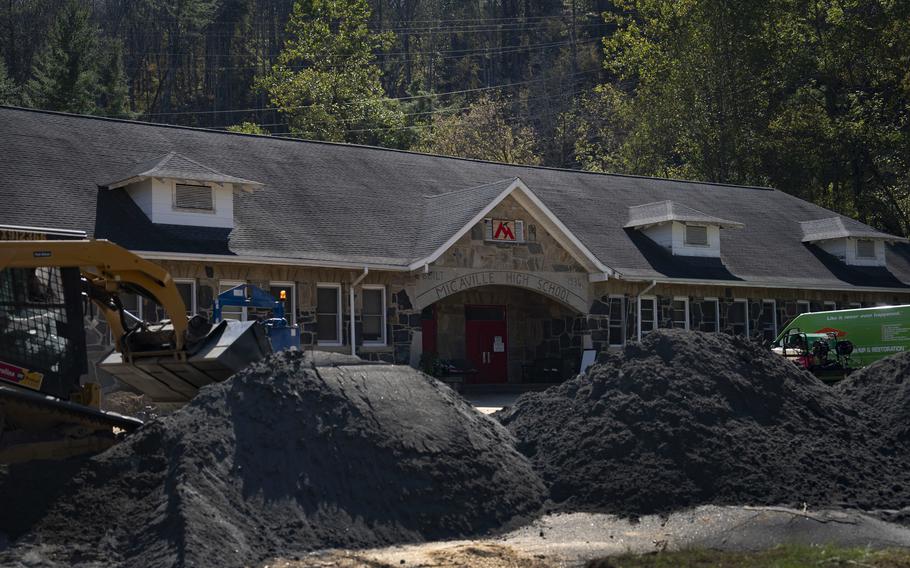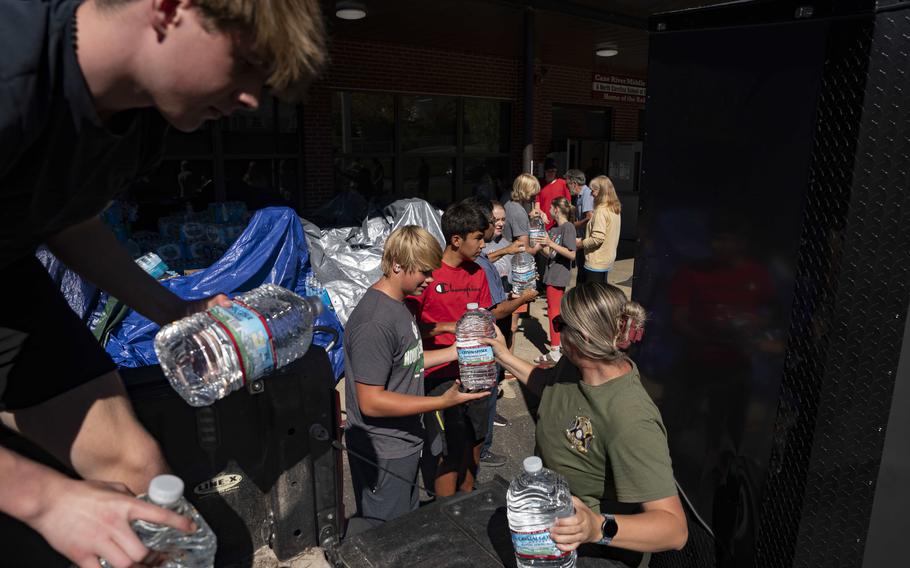
Piles of post-storm dirt and debris in the wake of Helene outside a school in Burnsville, N.C. (Allison Joyce/The Washington Post)
A week after Helene’s floodwaters swept through western North Carolina, Chris King returned to his middle school classroom for one last time.
Maintenance crews had already tried to salvage valuable educational materials from the Valle Crucis School in Watauga County, where more than a dozen classrooms flooded, some with as much as five feet of water. While King’s seventh- and eighth-grade English classroom was in a more elevated part of the school and spared, he and the rest of the teachers, staff and roughly 400 students won’t be coming back to this campus nestled in the mountains. He had gone back to save some personal mementos: family photos, a painting a former student had given him, the name plate on his door.
“As I was pulling it off, there were tears in my eyes,” said King, 52, who grew up in the county and has been teaching in the district for 27 years. “I cannot express enough what this community means.”
Helene had damaged the school beyond repair. When classes restart for the school’s pre-K to eighth-grade students - on a date yet unknown - Valle Crucis is planning to relocate to a temporary space, King said. Faculty and students will be sent to a nearby community center or a local community college. Eventually, the school will move into a new campus on higher ground, one that was already under construction and survived the storm.
Watauga County is just one of at least 16 school districts across three states that remain closed since Hurricane Helene first made landfall in late September. At least 76,000 students have not returned to their classrooms since then, and experts say when - or if - they do come back will not only determine how the students, families and staff themselves recover, but also how the communities bounce back overall.
The status of schools after a natural disaster can serve as a key indicator of where a community is in its recovery, said Lori Peek, director of the Natural Hazards Center at the University of Colorado at Boulder. In the aftermath of Helene, schools, even those with minimal facility damage, have largely stayed closed in places where roads remain impassable, and power and water are still cut off. But the longer schools stay shuttered, the longer it takes for the surrounding community to return to normalcy, Peek and other experts said. And if the schools close permanently, that can spell real trouble.
“If we want to ask the question, ‘Why did that community bounce back more quickly? Why does that community seem so much more vital and vibrant and alive when compared to this community?’ You may need to look to what happened with their schools in order to answer that question,” said Peek, who studies school closures in the wake of natural disasters, including hurricanes.
In North Carolina’s hard-hit Buncombe County, which includes Asheville, schools have been closed since Helene devastated the area, leaving tens of thousands without power, water, and internet and cell service for weeks. Much of Asheville still doesn’t have access to clean, potable water, with officials warning it could take weeks or months for taps to start flowing again. The lack of water has been one main barrier to schools in Buncombe County and Asheville reopening. Asheville City Schools Superintendent Maggie Fehrman said Thursday that all the district’s campuses had non-potable water, adding that she was “fully confident” schools there could reopen on Oct. 28.
Meanwhile, officials in Buncombe County, which serves more than 22,000 students, announced Friday that non-potable water service, power and internet had been restored to all schools and classes would resume Oct. 25.
“This all really speaks to the interconnection of these different recovery functions,” Peek said. “If we don’t have the water, but we have the power, we have the functioning school building, we’re still not going to be in school most likely.”
Schools, Peek and other experts said, should be considered critical infrastructure, and long-term closures could have far-reaching ripple effects.
“Schools are so integral to community life and community functioning,” Peek said. “When schools close, that is a core aspect of community function that ceases to be a part of community life.”

A sheriff, teachers, students and volunteers help unload donations at Cane River Middle School in Burnsville, N.C., which has turned into a relief and donation center in the wake of Helene. (Allison Joyce/The Washington Post)
The longer students stay out of school, the more they’ll have to work to catch up to peers who never left the classroom.
After Hurricanes Katrina and Rita hit the Gulf Coast in 2005, students who missed school because they had to evacuate saw their test scores drop sharply in the first year after the storm - although they eventually caught up to their peers after two or three years, according to the National Bureau of Economic Research.
Researchers found similar test score drops after Hurricane Maria hit Puerto Rico in 2017 and after Hurricane Floyd hit North Carolina in 1999.
The more time students spent outside of the classroom, the more their scores dropped, according to a 2008 study on Hurricane Katrina from Rand, a U.S. think tank.
In North Carolina’s Burke County, schools were closed for nearly two weeks after Helene, eventually reopening on Oct. 9. In that time, high school humanities teacher John Zimmerman estimates he could have covered a novel and two plays.
“It’s impossible to try to recover that much lost curriculum,” said Zimmerman, who now teaches at the North Carolina School of Science and Mathematics in Morganton. “It’s especially impossible … when the students who have been impacted by it most are also going through homelessness situations because their houses have been washed away.”
Other students may have loved ones who were injured or killed. These traumatic events can weigh on students long after the storm has passed - and that can make the adjustment overwhelming even when they do return to school. When classrooms started to reopen in New Orleans after Hurricane Katrina, “some kids who were back in the school building weren’t learning either because their lives were just so disrupted,” Peek said.
Zimmerman worries about gaps that may emerge between students in the storm-struck western reaches of North Carolina and students in the east, who were relatively spared.
“I’m most concerned about K-12 public school across the state, these disparities from the west to the east that are going to erupt,” he said.
But it’s not just about grades and test scores.
Reopening schools is one of the best ways to help kids emotionally recover from disasters, said Betty Lai, an associate professor in counseling psychology at Boston College.
“Routines are very comforting for children,” she said. “Being able to go back to school, go back to your regular routine, see your friends and see the adults that you know that care about you in the school building, is really important for returning to normalcy.”
King, the middle school English teacher in Watauga County, said he was looking forward to that as much as the students may be.
“When we get back into the building, whatever that looks like, we’ll spend a little bit of time just chilling and hanging out and decompressing together,” he said. “Then we can jump in.”
On a recent Wednesday morning, King’s 11-year-old daughter paced around their temporary home in Blowing Rock. She was eager to get going and impatient for her parents to get in the car.
She was due to be at school in 15 minutes for her first day back since the hurricane - and she didn’t want to be late.